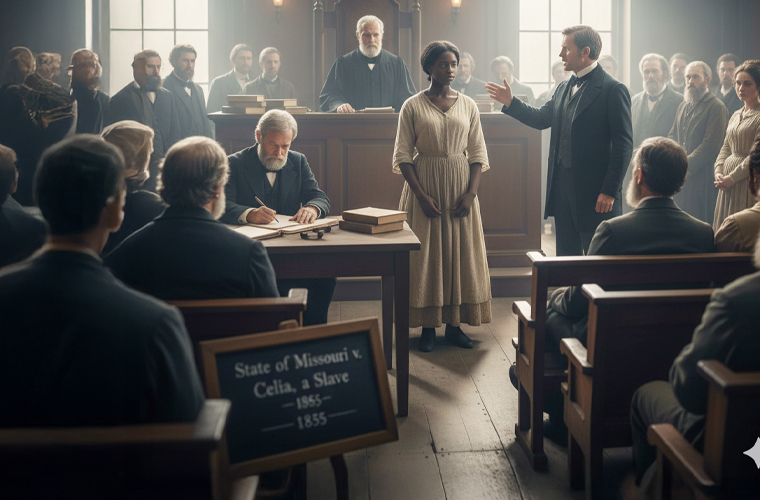Case Summary: Celia, a Slave
Defendant: Celia, an enslaved woman
Charge: Murder
Defense Attorneys: Isaac M. Boulware, John Jameson, Nathan Chapman Kouns
Prosecutor: Robert Prewitt
Judge: William Hall
Location: Calloway County, Missouri
Trial Dates: October 9–10, 1855
Verdict: Guilty
Sentence: Death by hanging
Significance: Celia’s case starkly highlights the lack of legal protections for enslaved women against rape by their enslavers. Missouri’s 1845 statute criminalized forcing “any woman” into non-consensual sex, yet Judge William Hall refused to interpret “any woman” as including enslaved women like Celia. This denied the jury the option to view her killing of her abusive enslaver, Robert Newsom, as justifiable self-defense.
Background
In 1850, Robert Newsom, a widowed Missouri farmer, purchased 14-year-old Celia, purportedly to assist his daughters with household tasks. On the journey from Audrain County to his Calloway County farm, Newsom raped Celia. He housed her in a cabin 150 feet from his home, where, over the next five years, she bore two of his children, both deemed his property. Celia formed a relationship with another enslaved man, George, who, in 1855, demanded she end her forced sexual relationship with Newsom after she became pregnant again, uncertain of the father.
Celia appealed to Newsom’s daughters, Virginia (36) and Mary (19), citing her pregnancy-related illness and begging them to intervene. They did not act. On June 23, 1855, Celia directly confronted Newsom, who dismissed her pleas and declared he would visit her cabin that night. Preparing for his arrival, Celia armed herself with a heavy stick. When Newsom arrived and refused to relent, she struck him twice, killing him. She burned his body in her fireplace, pulverizing smaller bones and hiding larger ones under the hearth. She enlisted Newsom’s grandson, Coffee Waynescot, to unknowingly dispose of the ashes.
Investigation and Arrest
By June 24, Newsom’s absence alarmed his family and neighbors. They interrogated George, who implicated Celia before fleeing. Newsom’s sons, Harry and David, and neighbor William Powell questioned Celia, who initially denied involvement. Fearing the Newsom brothers, she confessed to Powell after they left the room. A search of her cabin revealed Newsom’s buttons and bone fragments, confirming her account. On June 25, David Newsom’s affidavit led to Celia’s arrest and imprisonment in Calloway County jail. Sheriff William T. Snell allowed further interrogations by Thomas Shoatman and Jefferson Jones due to fears of accomplice slaves.
The Trial
Celia’s trial began on October 9, 1855. Her defense team entered a not guilty plea, arguing she acted in self-defense. Because enslaved people were barred from testifying in court, Celia’s statements came from her interrogations. Prosecutor Robert Prewitt presented Jefferson Jones, who recounted Celia’s confession, though he was vague on whether she explicitly described Newsom’s initial rape. Virginia Waynescot testified about finding her father’s remains, while Coffee confirmed disposing of the ashes. Defense attorney Jameson cautiously probed Virginia and Coffee about Newsom’s relationship with Celia but elicited little.
William Powell testified to Celia’s confession, including her pleas to Newsom’s daughters and her desperation to stop his abuse. Defense witness Dr. James M. Martin was blocked from testifying about the time required to burn a body, as Judge Hall sustained prosecution objections. Thomas Shoatman testified that Celia struck Newsom to prevent further sexual assault, but Hall struck this testimony from the record.
Jameson proposed jury instructions asserting that Missouri’s rape statute applied to enslaved women and that Celia’s actions were justifiable self-defense. Judge Hall rejected these, refusing to equate enslaved women with “any woman” under the law. Missouri law viewed enslaved women as property, rendering rape by an enslaver legally akin to trespass on one’s own property. On October 10, the jury found Celia guilty, sentencing her to hang on November 16, 1855. During or soon after the trial, Celia suffered a stillbirth.
Appeal and Execution
Jameson appealed to the Missouri Supreme Court, requesting a stay of execution. The court agreed to review the case but denied the stay. Unidentified Calloway County residents briefly freed Celia from jail to delay her execution. Jameson wrote to Justice Abiel Leonard, arguing that Judge Hall had blocked all defense arguments. On December 14, 1855, the court, including pro-slavery justices William Scott and John F. Ryland, found no basis for appeal and refused a stay.
In a December 20 interview with the Fulton Telegraph, Celia described her actions, stating the “Devil got into me” after striking Newsom. She was executed by hanging on December 21, 1855.
Celia’s case underscores the legal system’s failure to protect enslaved women from sexual violence, exposing the dehumanizing realities of slavery and the limits of justice for the enslaved.

